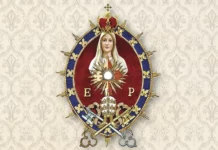The sin of our first parents was a real tragedy for human nature; through Eve, “the mother of all the living” (Gn 3:20); its disastrous consequences were transmitted to Adam’s posterity. On the other hand, the Lord denounced the Serpent who proposed the temptation: “I will put enmities between thee and the woman, and thy seed and her seed: she shall crush thy head” (Gn 3:15). It was only after several millennia that Providence, as a kind of retaliation, sent that New Eve – identified by Tradition with Mary Most Holy – who makes up for the fault of the old Eve, and crushes the devil.
St. Augustine wonders why God waited so long to redeem the human race, and he replies that, since it is something that would endure forever, it was necessary that the Redemption should be foretold at length by a series of heralds (cf. In Ioannis Evangelium. Tratactus XXXI, n.5), the last of whom was undoubtedly Our Lady herself. Her fiat not only announced but brought about the advent of the Messiah (cf. Lk 1:38), and in her virginal cloister, by an unfathomable mystery, her blood blended with the redeeming Blood – Sanguis Christi, sanguis Mariæ – symbolically confirming her role, albeit relative, in the sacrificial remission of the first sin.
Later, on Calvary, during Christ’s sufferings, Our Lady’s weeping would announce the Redemption. After the Crucifixion, the Body of Jesus would be deposited once again in the lap of His pious Mother, whose tears would mingle with the redeeming Blood. Finally, at Pentecost, it was through Her that the new regime of graces born of the sacrifice of the Divine Lamb would begin.
Based on these considerations, it is possible to deduce the corredemptive mission of the Mother of God – not only because Pontiffs and theologians have pronounced themselves in this regard, but also because of the very congruence of the events narrated in Sacred Scripture.
If analysed superficially, the expression Co-Redemptrix may appear excessive. Yet if this and so many other titles attributed to Our Lady by the Church down the centuries were the fruit of pious exaggeration, it would be difficult to understand why She foretold in the Magnificat that all generations would call Her blessed (cf. Lk 1:48).
If Mary Most Holy were only Mother, as the Lutherans preach, how can it be explained that throughout the centuries She has given birth to children redeemed by the promise of the Saviour (cf. Jn 19:26-27)? If She were just any woman, as one hears in anti-Catholic circles, why would her Divine Son send Her as a messenger in various apparitions throughout the ages? These questions only reinforce in our hearts Mary’s central role in the divine designs.
A plethora of Saints, Popes and Our Lady herself have foreshadowed a future Marian era, for which She is already preparing her beloved children. Considering the apex of sin that the world has reached today, why not suppose that this will take place by means of an analogous “redemption”, whose characteristics have not yet been revealed to us? Nothing would be more plausible. And if our hypothesis is confirmed, new Marian attributes will emerge from the lips of the faithful, confirming the famous saying of St. Bernard: “One can never say enough about Mary.” ◊




